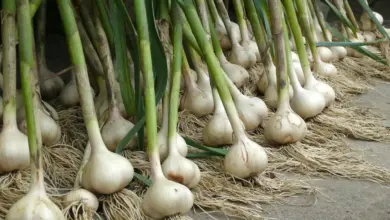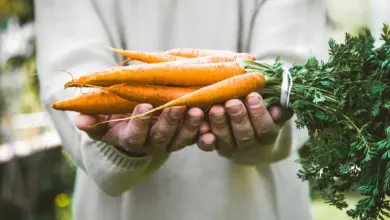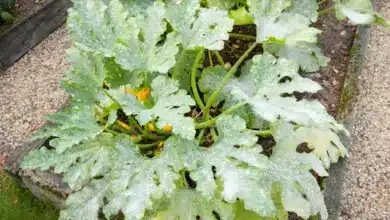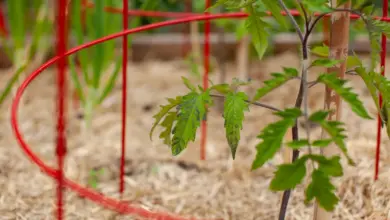Ever wondered how I grow Asparagus? Although I’ve been gardening for many years, I didn’t always grow asparagus. I was reluctant to dedicate a garden to a perennial that would last a lifetime. But over time, I realized how much I missed out on nature’s most beautiful gift.
The flavour of home-grown asparagus can’t be beaten, and its sweetness is out of this world. It also looks stunning. The tall, ferny foliage makes a beautiful backdrop for your other plants. This is especially true if you grow female asparagus plants that produce red berries that hang from the plants like ornaments. You can roast, steam, sauté or blanch asparagus. Add butter, garlic or lemon to enhance the flavour. Here’s what you need to grow asparagus.
The red berries that appear on the female asparagus plants are not only attractive but also drain energy from the plant. Plant breeders developed male-only varieties to increase the spears produced by an asparagus patch.
The asparagus plant is known for its long life span. It is not unusual for asparagus patches to produce tasty spears up to 20 years after they were first planted. This is a fantastic return on investment.
While asparagus can be grown from seeds, most gardeners prefer to start their asparagus plants with crowns. These are roots that are 1 year old and have buds. Asparagus is usually sold in 25-packs. Once established, 25 crowns produce 20 pounds of spears per year.
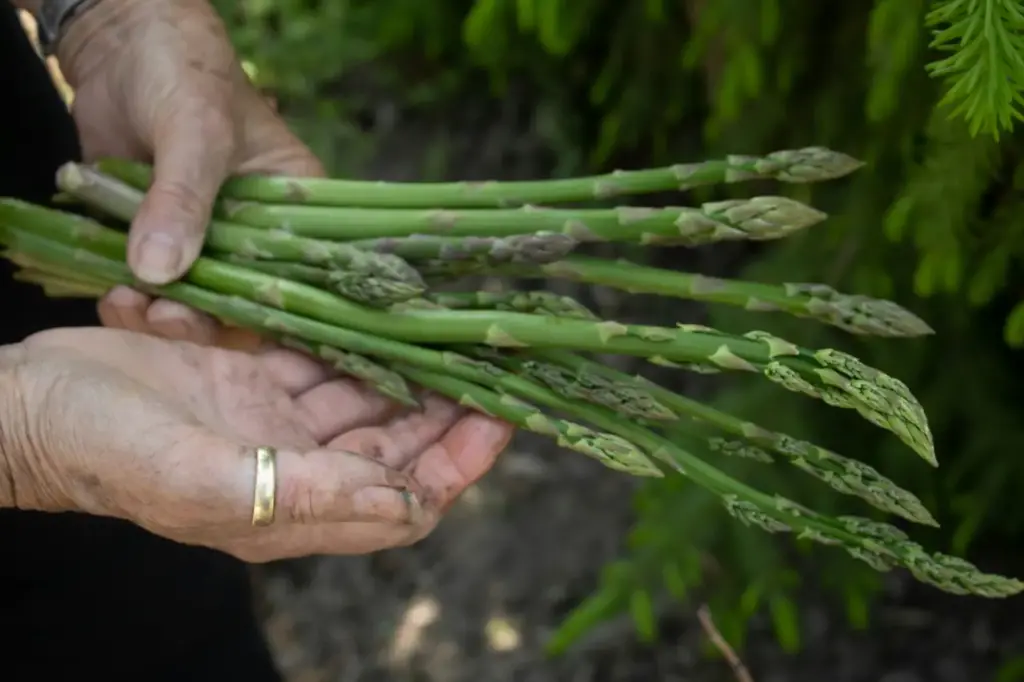
Asparagus Seeds: How to Plant them
Use only pathogen-free seeds from a reputable source if you decide to use seed. Asparagus seeds can be stored for up to three years in perfect conditions. However, for best results, you should use them the first year.
Start asparagus seeds 12-14 weeks before the spring’s last frost. Soak the seeds for several hours in water before planting to speed up germination. Sow seeds half an inch to three quarters of an inch deep in a seed-starting media that is clean. The seeds will germinate within 8-12 days if the temperature of the seed starting medium is between 60deg to 85deg.
From the moment the seeds sprout, keep them under a grow-light. If they are not kept under a grow light, they will spread out to find the sun. Start hardening off the asparagus seedlings ten days before you intend to plant them. This will help them become accustomed to the outdoor environment. The first day, expose them to the sun for an hour. The second day, you can increase the time spent in the sun by two hours. By the end of this period, you should be able to transplant the plants in full sunlight.
Asparagus Planting: When, Where & How?
As asparagus can be productive for up to 20 years, it is important to select the right spot. As the plants grow, they will develop fern-like leaves. Choose a spot that receives full sun so the foliage doesn’t shade other plants. Ideal is the north side of your garden or a space that can be left untouched for many years.
The pH of the soil should be neutral, somewhere between 6.5-7.5. The plants can better absorb nutrients when the pH level is within the right range. Your local cooperative extension can test your soil to determine the pH and provide you with suggestions on how to correct it if needed. You can also find out if there are any micronutrient deficiencies by conducting a soil test.
You should not plant seedlings outside until the soil temperature reaches 50deg. A cheap soil temperature will give you an accurate reading.
Plant crowns early in the spring, unless you are in a warm area where you should plant crowns from autumn through winter.
Plant crowns 5 to 8 inches deep in all cases. The bud side up, and the roots spread apart. In heavy soil, it is best to plant shallow. Plant deeper in colder climates. Allow 8 to 14 inch between crowns, and 3 to 6 foot between rows.
Backfill furrows only to the surface of the soil after planting. Cover the furrow with only 2 to 3 inches at the time of planting, and gradually fill in the furrows as the spears grow longer.
Asparagus Variety
Asparagus officiinalis is the common name for all garden asparagus. Asparagus comes in many varieties that can tolerate either warm or cool climates, and have varying levels of disease resistance. Asparagus can be purple, green or green with purple tips.
The pigment anthocyanin is what gives certain asparagus spears or tips their purple color. The “white asparagus” that is so popular in Asia and Europe is actually green asparagus covered with mulch or soil. The spears are more tender because they were not allowed to get sunlight.
- Erasmus, the first purple asparagus with all males is available. The texture and flavor are more tender than average asparagus. It is designed for an early harvest in zones 3-10.
- Guelph Millenium was developed by the University of Guelph, Ontario. The spears are solid green and tasty. It is cold-tolerant and highly productive. The RHS Garden Merit Award winner is suited to grow in Canada and northern United States.
- Jersey Giant belongs to the Jersey series, which is a group of male-only asparagus varieties. It has large, medium-sized spears with attractive purple bracts. This variety is resistant to rust and cold.
- Jersey Knight is characterized by large, uniformly-sized spears of green color. It is a hardy plant that grows in all climates. It is more resistant to fusarium.
- Jersey Supreme has a high yielding, slim spears of green. It’s resistant to rust and is a good choice for both warm and cool climates.
- Mary Washington Improved produces more spears with tighter tips and is open-pollinated. It has the same great flavor as its predecessor. It can’t withstand high temperatures, so don’t cut the spears when the temperature exceeds 70deg.
- Pacific Purple, a British asparagus with a high yield and flavor, is an excellent choice. It produces deep purple spears that are extra thick. If you grow it from seed, expect to wait 750 days before harvesting. Pacific Purple is suitable for zones 3 through 9.
- Purple Passion produces large, purple spears with a sweeter taste and texture than the green varieties. The purple variety emerges later, which is an advantage for avoiding frost damage. When the spears are roasted, the purple color fades.
- Spartacus has a hybrid that is all-male, green with purple-tinged tip and is more productive than Jersey varieties. Spears are always long, more than nine inches. This variety can be adapted to both cold winters as well as warm summers.
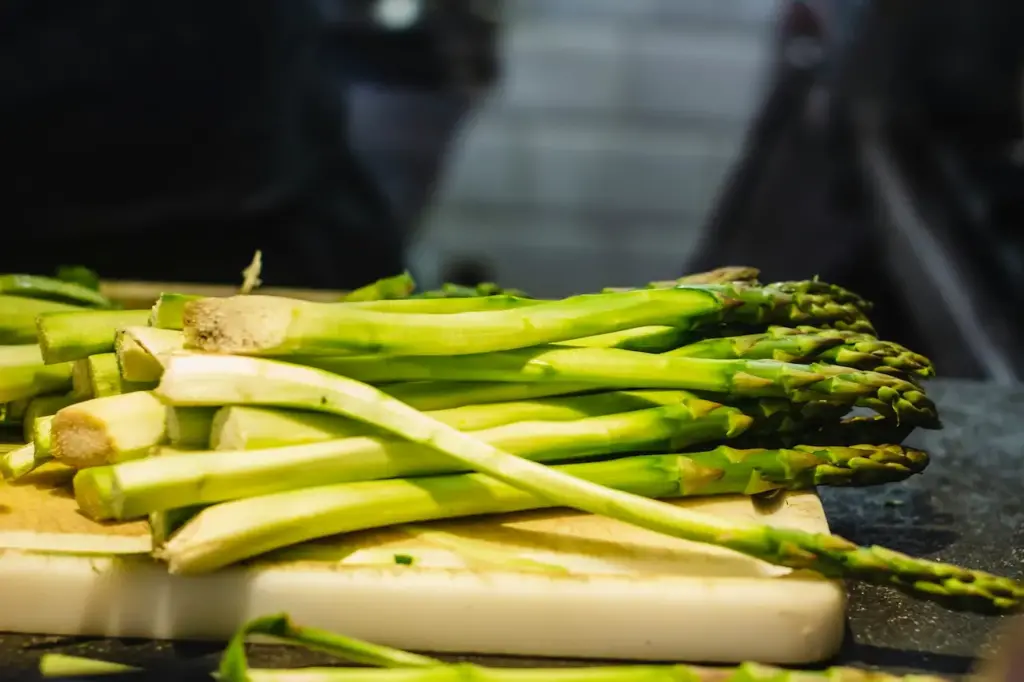
Watering Asparagus
During the first planting phase, it is crucial to water asparagus consistently and evenly. Avoid watering the foliage from above, as this can introduce pathogens. Water only at ground level. Mulch will help to retain moisture and create a barrier for the foliage against soilborne pathogens.
Asparagus makes a great candidate for drip irrigation, because the tubing as well as the plants can be left in place for years. Drip irrigation keeps the soil moist throughout the growing season.
Fertilizing Asparagus
Asparagus will benefit from a constant supply of nutrients, such as well-rotted compost, fish emulsion, or a balanced organic fertiliser. Organic mulch can also be used to provide nutrients for the soil.
As perennials asparagus plants can continue to grow and produce for many years. Ensure that key resources are available during their active growth period to ensure productive plants season after season.
Asparagus Pests and Diseases
By choosing resistant varieties of asparagus and using organic controls, you can overcome pest and disease problems. By installing floating row covers over plants, you can prevent many insects from ever laying eggs. The row cover will need to be removed when the plants are taller. However, during the time it is there, it can make a huge difference. Pests and diseases can be reduced by controlling weeds, not watering overhead, and using sanitized harvesting tools.
Asparagus Aphids can cause stunted and deformed growth by feeding on spear tips. Aphids, sucking insects, are vectors of plant diseases. They excrete honeydew as they feed on the leaves of plants, which attracts other insects and ants. You can easily control them by slapping them with a strong stream of water, or using insecticidal soap.
Asparagus Beetlesare found in both the common and spotted variety. Common asparagus beetles are the most dangerous because they lay their eggs on spears and then feed upon them, causing damage and deformity. The spotted spear beetle feeds on asparagus, but lays eggs on fern leaves.
Cutworms can cause stems to be bent or crooked. Caterpillars feed on stems and roots. Row covers won’t solve a cutworm problem because the larvae will overwinter in eggs or larvae. Cutworms can be reduced by staying on top of the weeding.
Japanese beetles may cause severe damage to the foliage, resulting in a loss of photosynthesis. This results in a reduced plant productivity and vigor. A Japanese beetle adult is approximately 3/8th inch in length. The wing covers are metallic, like copper and green fluorescent. Its abdomen is covered with five white hairs on either side. The larva of a Japanese beetle is a small white grub. It can grow up to one inch in length. In the soil, grubs can be found curled up. Bacillus galleriae, milky spores and parasitic nematodes can be used to control grubs. Adults can also be controlled organically with Btg or by handpicking. You can read more about Japanese Beetle Prevention & Control .
Fusarium causes root rot, crown roots, and general wilting.
The purple spot causes tan, brown or tan lesions to appear on the leaves and stalks.
Rust produces orange spores on plant stalks.
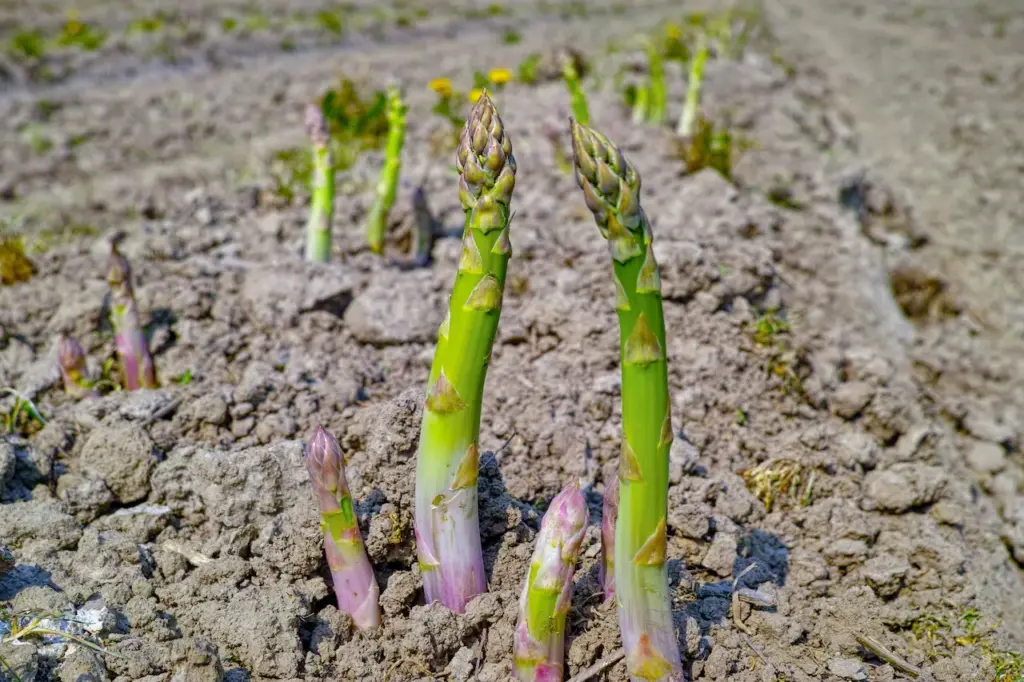
Harvesting Asparagus
The second spring following crown planting, you will have your first chance to harvest asparagus. It will take an extra year to harvest spears from seed-grown asparagus.
When you harvest your first plant, take only two or three spears. When they reach 6-8 inches in height, you can harvest the pencil-thick stalks. As long as the spears are larger than 3/8 inch, you can continue harvesting. When the bud tips begin to open and expand, you’ll know that it’s time for harvesting to cease. The remaining ferns continue to grow and provide energy for the plants underground.
The best part of the spear is the end that ends up in your hand. The part that ends up in your hands is the part you’ll want to eat. You’re better to leave the lower part of the spear in the garden than cut it off.
Enjoying asparagus as fresh as possible is the best way to enjoy it. Plan to serve the vegetable on the harvest day or as soon after as you can.
Cut back the ferny growth at the end of every growing season. It will turn brown and stiff in the fall. The cut growth can be left in place to act as mulch. This is also a great time to add compost and other soil amendments. Cover the soil bare with straw, shredded leaves or other mulches after you have completed your maintenance.

